Moving from Requires Improvement to Expected Standard

A Strategic Guide for Further Education and Skills Providers
(Based on the Education Inspection Framework and FE & Skills Toolkit, effective November 2025)
1. Understanding the New Landscape
From November 2025, Ofsted’s new framework no longer gives single-word overall judgements. Instead, providers receive a report card across evaluation areas, with ratings ranging from Urgent Improvement through to Exceptional.
Being rated Needs Attention signals that you have the capacity to deliver good provision, but important weaknesses are holding back consistency and impact. The route to Expected Standard is about demonstrating that all core areas are delivered securely and reliably, with no major risks to learners, apprentices, or employers.
2. What “Expected Standard” Means
Across the toolkit, “Expected Standard” consistently describes provision that is:
- Reliable: Systems and practice are consistent, not patchy.
- Inclusive: All learners, including disadvantaged and SEND, are supported to succeed.
- Safe: Safeguarding is fully effective, proactive, and well understood.
- Effective: Curriculum, teaching, and assessment lead to positive achievement.
- Well-led: Leaders act with integrity, understand context, and avoid unnecessary burdens on staff.
3. Strategic Pillars for Improvement
A. Leadership and Governance
- Shift from firefighting to foresight. Leaders need to show they understand their provision, make realistic plans, and communicate priorities clearly.
- Create a culture of accountability and support. Governing boards and leaders must demonstrate challenge and care, balancing performance oversight with staff well-being.
- Model sustainability. The new framework looks closely at leader well-being and workload management. Leaders must embody sustainable practice themselves.
B. Inclusion
- Broaden the definition. Inclusion is not limited to SEND; it now encompasses disadvantage, care-experienced learners, and equality of opportunity.
- Strategic question: Are all groups of learners benefiting equally from what we do?
- Demonstrate action. Show how you adapt recruitment, curriculum, and learner support to remove barriers and close gaps.
C. Safeguarding
- From compliance to culture. Policies and checks are the baseline. “Expected Standard” safeguarding means staff and learners feel confident, well informed, and actively engaged in keeping each other safe.
- Strategic priority: Ensure safeguarding is embedded in the everyday curriculum and culture, not just in a safeguarding policy file.
D. Curriculum, Teaching and Training
- Relevance and progression. Apprenticeships and skills programmes must have clear purpose, logical sequencing, and demonstrable links to local and sector needs.
- Strategic lens: Does our curriculum prepare learners for their next step - employment, progression, or higher study?
- Consistency is key. Sporadic excellence is not enough; inspectors will look for sustained quality across learners, staff, and settings.
E. Achievement
- Secure the basics. Achievement at “Expected Standard” means learners complete, succeed, and progress broadly in line with expectations.
- Strategic question: Is performance secure across all major programmes, not just in pockets?
- Evidence through destinations. Show that apprentices and learners move on successfully to jobs, further learning, or progression routes.
F. Participation and Development
- Beyond enrolment. It’s not just who joins, but who stays, thrives, and grows.
- Strategic shift: Inspectors will look at retention, attendance, enrichment, learner voice, and personal development opportunities.
- Employer engagement matters. For apprenticeships, employers must be active partners, not passive recipients.
4. A Roadmap to Move Up
Step 1: Diagnose Honestly
- Use the toolkit’s descriptors as a mirror.
- Identify which areas currently sit below “Expected Standard” and why.
Step 2: Prioritise Leadership and Inclusion
- Weakness in either can undermine all other areas.
- Ensure strategic clarity: what do we want to be known for, and how will every learner benefit?
Step 3: Build a Culture of Continuous Reflection
- Replace “inspection readiness” with everyday readiness.
- Encourage staff to ask: If Ofsted visited tomorrow, would our learners’ everyday experience show the standards we aim for?
Step 4: Stabilise and Secure Consistency
- Focus on doing the basics well across the whole organisation.
- Small, sustainable changes are more powerful than headline initiatives.
Step 5: Evidence Naturally
- Avoid generating paperwork for inspection.
- Collect evidence that arises from normal systems: learner progress tracking, employer feedback, safeguarding records, staff surveys.
5. Risks to Avoid
- Quick fixes without depth. They unravel under inspection scrutiny.
- Overburdening staff. Extra paperwork or rushed initiatives will be noticed - inspectors now explicitly consider staff workload.
- Neglecting inclusion. Failure to support disadvantaged learners or apprenticeships with additional needs can prevent reaching “Expected Standard.”
6. Moving Mindset: From Needs Attention to Expected Standard
- From patchy to consistent
- From compliance to culture
- From reactive to proactive
- From isolated initiatives to whole-provider alignment
7. Final Message
Reaching the Expected Standard is less about radical transformation and more about sustained reliability, fairness, and consistency across the whole organisation. Providers who embrace the framework as a tool for improvement, rather than a hurdle to overcome, will find themselves not only inspection-ready but also better positioned to serve learners, employers, and communities.
Why not check out your readiness for the new inspection style by taking our short questionaire? You can find it here
You can download this blog post as a document here


